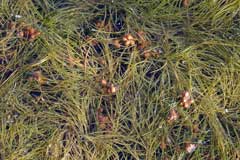 |
|
http://commons.wikimedia.org/wiki/File:Illustration_Ruppia_maritima0.jpg |
 |
| http://commons.wikimedia.org/wiki/User:Fice |
Translate this page:
Summary
Physical Characteristics
![]()
![]() Potamogeton pectinatus is a PERENNIAL at a fast rate. It is in flower from May to September. The species is hermaphrodite (has both male and female organs) and is pollinated by Water.
Potamogeton pectinatus is a PERENNIAL at a fast rate. It is in flower from May to September. The species is hermaphrodite (has both male and female organs) and is pollinated by Water.
It is noted for attracting wildlife.
Suitable for: light (sandy), medium (loamy) and heavy (clay) soils. Suitable pH: mildly acid, neutral and basic (mildly alkaline) soils and can grow in very alkaline soils.
It cannot grow in the shade. It can grow in water.
UK Hardiness Map
US Hardiness Map
Synonyms
P. flabellatus. P. interuptus. Kit.
Plant Habitats
Pond;
Edible Uses
Edible Parts: Leaves Root Stem
Edible Uses:
Leaves and stems[105]. No more details are given. Root - raw[105]. It tastes like nuts[85]. The outer rind should be removed[85].
References More on Edible Uses
Medicinal Uses
Plants For A Future can not take any responsibility for any adverse effects from the use of plants. Always seek advice from a professional before using a plant medicinally.
Hepatic
A decoction of the plant is used in the treatment of a feverish liver[218].
References More on Medicinal Uses
The Bookshop: Edible Plant Books
Our Latest books on Perennial Plants For Food Forests and Permaculture Gardens in paperback or digital formats.

Edible Tropical Plants
Food Forest Plants for Hotter Conditions: 250+ Plants For Tropical Food Forests & Permaculture Gardens.
More

Edible Temperate Plants
Plants for Your Food Forest: 500 Plants for Temperate Food Forests & Permaculture Gardens.
More

More Books
PFAF have eight books available in paperback and digital formats. Browse the shop for more information.
Shop Now
Other Uses
References More on Other Uses
Cultivation details
A submerged aquatic plant that can be used as an oxygenator of ponds[1]. It is best given a loam based medium in full sun[200]. A polymorphic species[17]. A fast growing plant in need of constant checking to make sure it does not overrun the pond[200]. It provides a very good food source for ducks and other water fowl[212]. Plants do not flower every year[212]. Hybridizes freely with other members of this genus, the resulting progeny is usually sterile[200].
References Carbon Farming Information and Carbon Sequestration Information
Temperature Converter
Type a value in the Celsius field to convert the value to Fahrenheit:
Fahrenheit:
The PFAF Bookshop
Plants For A Future have a number of books available in paperback and digital form. Book titles include Edible Plants, Edible Perennials, Edible Trees,Edible Shrubs, Woodland Gardening, and Temperate Food Forest Plants. Our new book is Food Forest Plants For Hotter Conditions (Tropical and Sub-Tropical).
Shop Now
Plant Propagation
Seed - we have no information for this species but suggest sowing the seed in a pot that is standing in its own depth of water in a greenhouse as soon as the seed is ripe if this is possible. Stored seed is likely to have a short viability. Prick out the seedlings when they are large enough to handle and increase the depth of water around the pot until the plants are covered by a few centimetres of water. Grow the plants on in a sunny position in the greenhouse for their first winter, increasing the depth of water as the plants grow larger. Plant them out into their permanent positions in early summer. Division in spring[56]. Cuttings of erect shoots in the growing season[56].
Other Names
If available other names are mentioned here
Native Plant Search
Search over 900 plants ideal for food forests and permaculture gardens. Filter to search native plants to your area. The plants selected are the plants in our book 'Plants For Your Food Forest: 500 Plants for Temperate Food Forests and Permaculture Gardens, as well as plants chosen for our forthcoming related books for Tropical/Hot Wet Climates and Mediterranean/Hot Dry Climates. Native Plant Search
Found In
Countries where the plant has been found are listed here if the information is available
Weed Potential
Right plant wrong place. We are currently updating this section.
Please note that a plant may be invasive in one area but may not in your area so it’s worth checking.
Conservation Status
IUCN Red List of Threatened Plants Status :

Growth: S = slow M = medium F = fast. Soil: L = light (sandy) M = medium H = heavy (clay). pH: A = acid N = neutral B = basic (alkaline). Shade: F = full shade S = semi-shade N = no shade. Moisture: D = dry M = Moist We = wet Wa = water.

Expert comment
Author
L.
Botanical References
17
Links / References
For a list of references used on this page please go here
Readers comment
| Add a comment |
|
If you have important information about this plant that may help other users please add a comment or link below. Only comments or links that are felt to be directly relevant to a plant will be included. If you think a comment/link or information contained on this page is inaccurate or misleading we would welcome your feedback at [email protected]. If you have questions about a plant please use the Forum on this website as we do not have the resources to answer questions ourselves.
* Please note: the comments by website users are not necessarily those held by PFAF and may give misleading or inaccurate information.
To leave a comment please Register or login here All comments need to be approved so will not appear immediately.
|
Subject : Potamogeton pectinatus
|
|
|
|